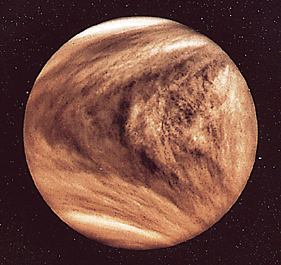A New Spin on Venus
Feb. 16, 2012
To the surprise of scientists, data from the Venus Express space probe have indicated that Venus is rotating much more slowly than it was only 16 years ago. As a result, a day on Venus is now an average of 6.5 minutes longer. Why? For now, scientists are puzzled, though the reason may lie in the thick blanket of clouds that has long kept the planet shrouded in mystery.
The discovery of the slowdown was announced by scientists with the European Space Agency (ESA) who have been using an infrared device on the Venus Express to study surface features on the planet. A comparison of these images with radar maps of Venus made by NASA‘s Magellan spacecraft in the 1990′s at first caused the ESA scientists to think their calculations were seriously wrong. During Magellan’s four-year mission, scientists had determined the length of a Venusian day by measuring the speed at which surface features passed beneath the orbiting probe. ESA scientists were confident that the Magellan measurements were accurate. But now, certain features were up to 12.4 miles (20 kilometers) away from where the ESA scientists thought they would be. Additional checks for possible errors led the scientists to conclude that the planet was, in fact, rotating more slowly. Since 1996, the length of a day on Venus has increased from an average of 243.0185 Earth days to an average of 249.5185 Earth days.

Thick clouds of sulfuric acid cover Venus, hiding its surface from most forms of light. The Pioneer Venus 1 orbiter took these pictures of the planet's atmosphere in ultraviolet light. Many kinds of light cannot penetrate the clouds. To map the surface, astronomers rely on spacecraft instruments that use radio waves, such as radar. NASA
Venus’s incredibly dense atmosphere may explain the mysterious slowdown. The atmospheric pressure on Venus is a crushing 90 times as great as the pressure at sea level on Earth. At the cloud tops, winds often blow at hurricane-force speeds of 200 miles (320 kilometers) per hour. Some scientists have speculated that friction between the surface and the turbulent atmosphere may be slowing the planet. They also suggested that the slower rotation rate may be part of a long-term weather cycle. The length of a day on Earth may also vary because of tides and winds. But on our home planet, a day may change by only a millisecond a year.
Additional World Book articles:


